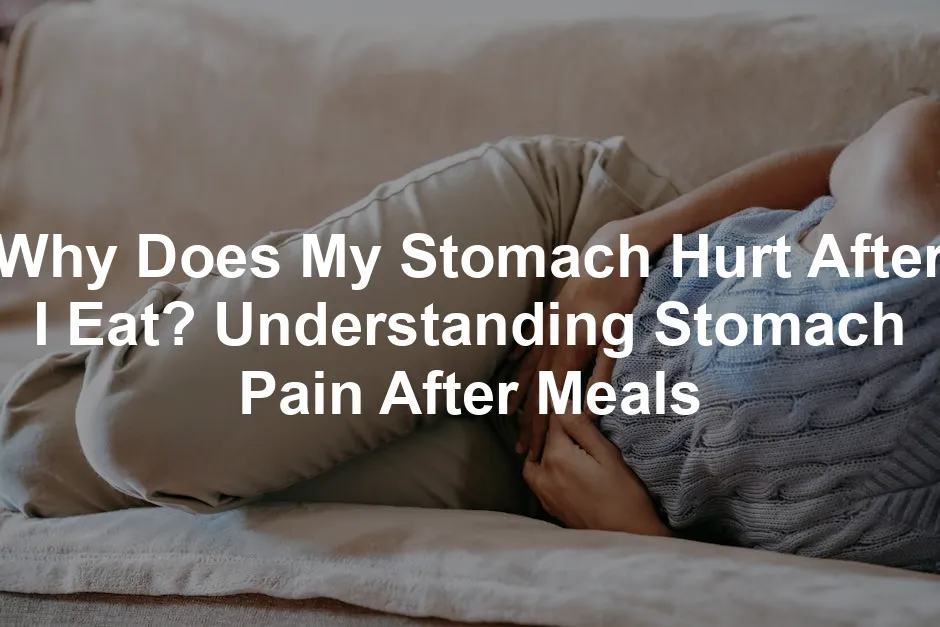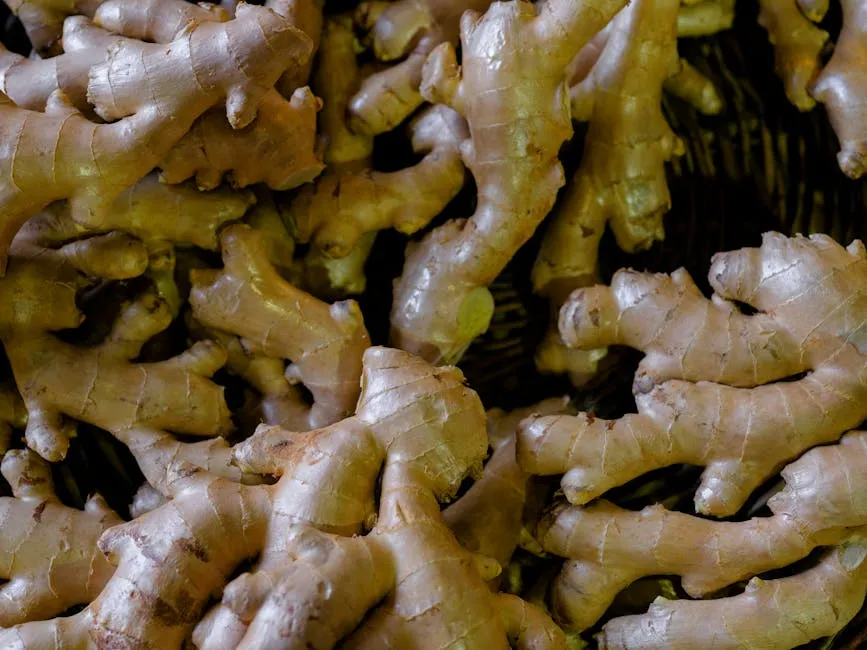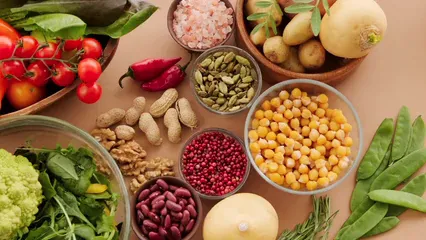
Why Does My Stomach Hurt After I Eat? Understanding Stomach Pain After Meals
Introduction
Eating should be a delightful experience, but for many, it can quickly turn into a painful ordeal. If you’ve ever found yourself pondering, “Why does my stomach hurt after I eat?” you’re not alone. Many people grapple with this uncomfortable issue, which can stem from a variety of causes—some benign and others more serious.
Stomach pain after meals can be perplexing. It might feel like your belly is staging a protest, and you’re left wondering what went wrong. The truth is, understanding the potential triggers is key to preventing this discomfort.
A host of factors can lead to post-meal stomach pain. Maybe you indulged in one too many slices of pizza or forgot to chew your food properly. A faster-paced lifestyle often leads to eating on the go, which can invite digestive troubles. Or perhaps you’ve got a food intolerance that’s waiting to rear its ugly head at the most inconvenient times.
From food intolerances and allergies to more serious underlying medical conditions, the reasons can vary widely. Common culprits include overeating, consuming too quickly, and indulging in rich or spicy foods. For some, the discomfort may arise from conditions such as gastritis, irritable bowel syndrome (IBS), or even peptic ulcers.
In this article, we will dissect the reasons behind post-meal stomach pain, empowering you with knowledge to identify potential triggers and understand when it’s time to seek medical help. So, let’s venture into the world of digestive woes and uncover why your tummy might be throwing a tantrum after dinner.
Knowledge is power, and by the end of this guide, you’ll have a clearer understanding of your symptoms. You’ll also know the next steps to take for relief. Understanding your body is the first step in ensuring your meals remain a source of joy rather than discomfort.

Understanding Stomach Pain After Eating
What is Stomach Pain?
Stomach pain refers to discomfort or aching sensations located in the abdominal area. It can be a pesky reminder that our digestive systems are not always on their best behavior. While many people use “stomach pain” to describe various issues, it’s crucial to understand that this term can encompass a range of sensations.
Abdominal pain, on the other hand, can involve any discomfort in the belly, including issues related to the intestines, gallbladder, or even reproductive organs. Essentially, if it’s below your ribs and above your pelvis, it’s fair game. Stomach pain is often localized, while abdominal pain can be more widespread and might signal different underlying issues.

Types of Stomach Pain
When it comes to stomach pain, there are generally two types: acute and chronic. Acute pain strikes suddenly and can be intense, often linked to specific events, such as a spicy meal gone wrong or a heavy dose of that leftover pasta. Chronic pain, however, lingers for an extended period and can come and go, often signaling a more significant health concern.
Common symptoms accompanying post-meal discomfort include bloating, cramping, and sometimes feelings of nausea. You might feel like your stomach is hosting a wild party, and not in a good way! This discomfort can vary from mild annoyances, like a slight ache, to severe pain that makes you reconsider that third helping of dessert. Understanding these nuances can help you pinpoint potential triggers and seek the right help if needed.
Now that we have a grasp on what stomach pain is and its types, let’s dig into the root causes of that post-meal discomfort.

Specific Food Types
When it comes to stomach pain after eating, not all foods are created equal. Some are more likely to cause discomfort than others. Let’s break down a few notorious offenders: spicy foods, fatty foods, and acidic foods.
Spicy Foods: Love that zing? You might want to hold back a bit! Spicy foods can irritate the stomach lining. If your stomach feels like it’s hosting a fire drill after a spicy taco night, it’s not just your imagination. Capsaicin, the active component in chili peppers, can annoy sensitive stomachs, leading to pain and discomfort. If your belly often protests after spicy meals, consider dialing down the heat. For those who still want that kick, check out this Spicy Hot Sauce that packs a punch without the pain!
Fatty Foods: Who doesn’t love a good burger or some crispy fries? Unfortunately, fatty foods can be slow to digest and may cause bloating. They often lead to a feeling of fullness that’s less than pleasant. If you find yourself clutching your stomach after indulging in a greasy feast, it could be time to swap out those fatty delights for leaner options. Your stomach may thank you!
Acidic Foods: Citrus fruits, tomatoes, and vinegar can trigger pain in many individuals, especially those with sensitive stomachs. The acidity can irritate the stomach lining and lead to discomfort. If you notice your stomach grumbling after a zesty salad, you might want to limit your intake of these acidic delights. A Citrus Juicer can help you enjoy those fruits without the acidity, making it easier to incorporate healthy options into your diet!
To better understand your body’s reactions to different foods, keeping a food diary can be invaluable. Jot down what you eat and any symptoms you experience. Over time, you’ll spot patterns and identify specific triggers. This knowledge is power! It helps you make informed choices about what’s on your plate. A handy Food Diary Journal can make this task a breeze!

Indigestion (Dyspepsia)
Indigestion, or dyspepsia, is a common culprit behind post-meal discomfort. It’s characterized by a range of symptoms, including bloating, nausea, and a burning sensation in the upper abdomen. You might feel like a balloon ready to pop! Often triggered by overeating, consuming rich foods, or eating too quickly, indigestion can be quite annoying.
Fortunately, relief is often within reach. Home remedies, such as herbal teas, ginger, or peppermint, can soothe your stomach. Over-the-counter antacids may also help alleviate symptoms by neutralizing stomach acid. If indigestion becomes a frequent visitor, it’s wise to consult a healthcare professional. They can help identify underlying issues and suggest tailored treatments. For a soothing solution, consider trying Peppermint Tea to help calm those digestive troubles!

Medical Conditions
Gastritis and Peptic Ulcers
Gastritis and peptic ulcers are notable conditions that can lead to stomach pain after eating. Gastritis is the inflammation of the stomach lining, often caused by factors like excessive alcohol consumption, stress, or certain medications. Symptoms include abdominal pain, nausea, and vomiting. Treatment typically involves dietary changes and medications to reduce stomach acid.
Peptic ulcers, on the other hand, are sores that develop on the stomach lining or the upper part of the small intestine. They can cause a burning sensation after meals, often exacerbated by spicy or acidic foods. Treatment usually includes medications to reduce acid and promote healing.

Irritable Bowel Syndrome (IBS)
IBS is a complex disorder affecting the large intestine. It can lead to a mix of symptoms, including cramping, bloating, diarrhea, and constipation. Managing IBS often requires a tailored approach, including dietary adjustments, stress management, and sometimes medication. Keeping track of triggers can be beneficial for those with IBS. A Cookbook for IBS-Friendly Meals can help you navigate your food choices effectively!

Gastroesophageal Reflux Disease (GERD)
GERD occurs when stomach acid flows back into the esophagus, causing heartburn and discomfort. This condition can lead to significant post-meal pain. Dietary modifications, such as avoiding spicy foods and reducing caffeine intake, can help manage symptoms. In some cases, medications like proton pump inhibitors may be prescribed.

Other Potential Medical Causes
Aside from the conditions mentioned, other potential causes of stomach pain after eating include gallstones, pancreatitis, and food poisoning. Gallstones can block bile ducts, leading to intense pain, especially after fatty meals. Pancreatitis, or inflammation of the pancreas, results in severe abdominal pain and may require hospitalization. Food poisoning can cause nausea, vomiting, and stomach cramps, often due to consuming contaminated food. If symptoms persist or worsen, it’s crucial to seek medical advice to rule out serious conditions.

Lifestyle Factors and Their Impact
Eating Habits
Eating isn’t just about filling your stomach; it’s an art! The way you eat can greatly influence how your digestive system reacts. Eating slowly and mindfully can make a world of difference. When you take your time, you allow your body to signal when it’s full, reducing the likelihood of overeating.
So, how can you improve your eating habits? Start by putting away distractions. That means no scrolling through your phone or binge-watching your favorite show during meals. Instead, focus on your food and savor each bite. Chewing thoroughly also aids digestion. It’s like giving your stomach a little break before it has to work overtime!
Another tip? Consider portion sizes. If you’re serving yourself a heaping plate, you might want to rethink that. Smaller, more frequent meals can help you avoid that stuffed-to-the-brim feeling. Don’t forget to listen to your body. If you feel that first hint of fullness, it’s okay to set your fork down. Trust me, your stomach will appreciate it. Using Portion Control Plates can help you master those servings!

Stress and Anxiety
Feeling stressed? Your gut might be feeling it too! Stress and anxiety can wreak havoc on your digestive system. When you’re anxious, your body enters fight-or-flight mode, which can slow down digestion and lead to discomfort.
To combat this, try relaxation techniques. Deep breathing exercises can work wonders. Just a few minutes of focused breathing can help calm your mind and ease stomach tension. Incorporating mindfulness practices such as meditation or yoga can also be beneficial. They not only help reduce stress but also promote better digestion. A Mindfulness Meditation Book can guide you through these practices!
Another simple technique is to take a moment to relax before your meals. A few deep breaths can prepare your body for the food it’s about to receive. When you’re calm, your body is more likely to handle food better, leading to fewer post-meal complaints.

When to See a Doctor
Let’s get serious for a moment. While occasional stomach pain is often nothing to worry about, certain signs require medical attention. If you experience severe pain that doesn’t improve within a couple of days or is accompanied by symptoms like vomiting blood, sudden weight loss, or changes in bowel habits, it’s time to consult a healthcare provider.
Remember, it’s better to be safe than sorry. Persistent stomach pain can indicate underlying issues that need addressing. Your doctor can provide the necessary evaluations and determine if any further tests are needed. Early intervention can help prevent more significant problems down the road. Don’t hesitate to seek help!

Conclusion
In conclusion, stomach pain after eating can range from minor discomfort to signs of serious health issues. Understanding the underlying causes—whether they be food-related, medical, or lifestyle factors—can significantly help in managing your symptoms. If you find that your stomach troubles persist or worsen, it’s crucial to consult a healthcare provider. By taking proactive steps and being mindful of your eating habits, you can enjoy your meals without fear of pain.

FAQs
Please let us know what you think about our content by leaving a comment down below!
Thank you for reading till here 🙂
All images from Pexels




